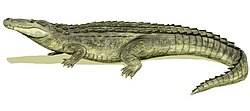| Prodiplocynodon Temporal range: Late Cretaceous, | |
|---|---|
| Scientific classification | |
| Kingdom: | Animalia |
| Phylum: | Chordata |
| Class: | Reptilia |
| Clade: | Archosauria |
| Order: | Crocodilia |
| Superfamily: | Crocodyloidea |
| Genus: | † Prodiplocynodon Mook, 1941 |
| Type species | |
| †Prodiplocynodon langi Mook, 1941 | |
Prodiplocynodon is an extinct genus of basal crocodyloid crocodylian. It is one of the only crocodyloids known from the Cretaceous and existed during the Maastrichtian stage. [1] The only species of Prodiplocynodon is the type species P. langi from the Lance Formation of Wyoming, known only from a single holotype skull lacking the lower jaw. [2]
Contents
The skull was collected by the American Museum Expedition of 1892 from exposures near the Cheyenne River in Niobrara County. It was described by Charles C. Mook of the American Museum of Natural History in 1941. [2] The generic name means "before Diplocynodon" because Mook saw close similarities between the holotype skull and that of the alligatoroid Diplocynodon from the Eocene of Europe.


